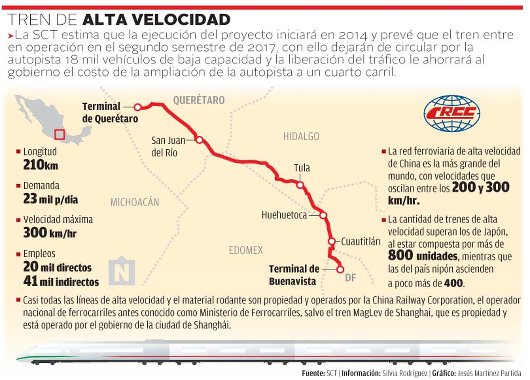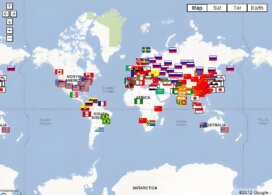Initial 2012 project
The Mexico-Queretaro Train, announced on December 1, 2012, aimed to become the first high-speed train in Latin America. This ambitious project sought to link Querétaro with Mexico City through a 210-kilometer travel distance, crossing the states of Mexico and Hidalgo.

The initial project contemplated only two terminals at the ends of the line and three maintenance stations along the route. The maximum speed of the train would be 300 kilometers per hour, although its average speed would be 180 kilometers per hour, and it would have the capacity to transport 23,000 passengers per day.
The project included the construction of 10 tunnels (with a length of 7.548 kilometers) and 21 viaducts (with a length of 19.576 kilometers), as well as the adaptation of 85.833 kilometers of existing track. The track gauge would be 1,435 millimeters, the standard used in Mexico and currently used by the Valle de Mexico suburban train.
In 2015, the project was cancelled due to suspicions of corruption related to then PRI president Enrique Peña Nieto.
Resumption of the project
After years of uncertainty, the Ministry of Communications and Transportation (SCT) announced in February 2020 that it would resume the Mexico-Queretaro High-Speed Passenger Train initiative, once the Tren Maya was completed.
After the collapse of the Mexico-Queretaro highway in 2023, the government of Andrés Manuel López Obrador signed an agreement with Kansas City Southern (KCS) to continue with the passenger train project.
KCS submitted a proposal for a Mexico-Queretaro passenger train, with the possibility of extending to Nuevo Laredo.
Track evaluation studies began in 2024, and in November 2023, the government announced the reactivation of seven passenger train routes, including two routes from Mexico to Queretaro:
- Mexico-Veracruz-Coatzacoalcos Train
- Interurban Train AIFA-Pachuca
- Mexico-Queretaro-Leon-Aguascalientes Train
- Manzanillo-Colima-Guadalajara-Irapuato Train
- Mexico-San Luis Potosi-Monterrey-Nuevo Laredo
- Mexico-Queretaro-Guadalajara-Tepic-Mazatlan-Nogales
- Aguascalientes-Chihuahua-Ciudad Juárez
President López Obrador announced in January 2024 that the concession for the construction of the high-speed train will be ready by the end of his administration.
Conclusion
The Mexico-Queretaro train represents a technical and logistical challenge for Mexico, but also an opportunity to boost the country’s economic and social development. The reactivation of the project by the López Obrador administration demonstrates its commitment to public transportation and the modernization of the country’s rail infrastructure.


